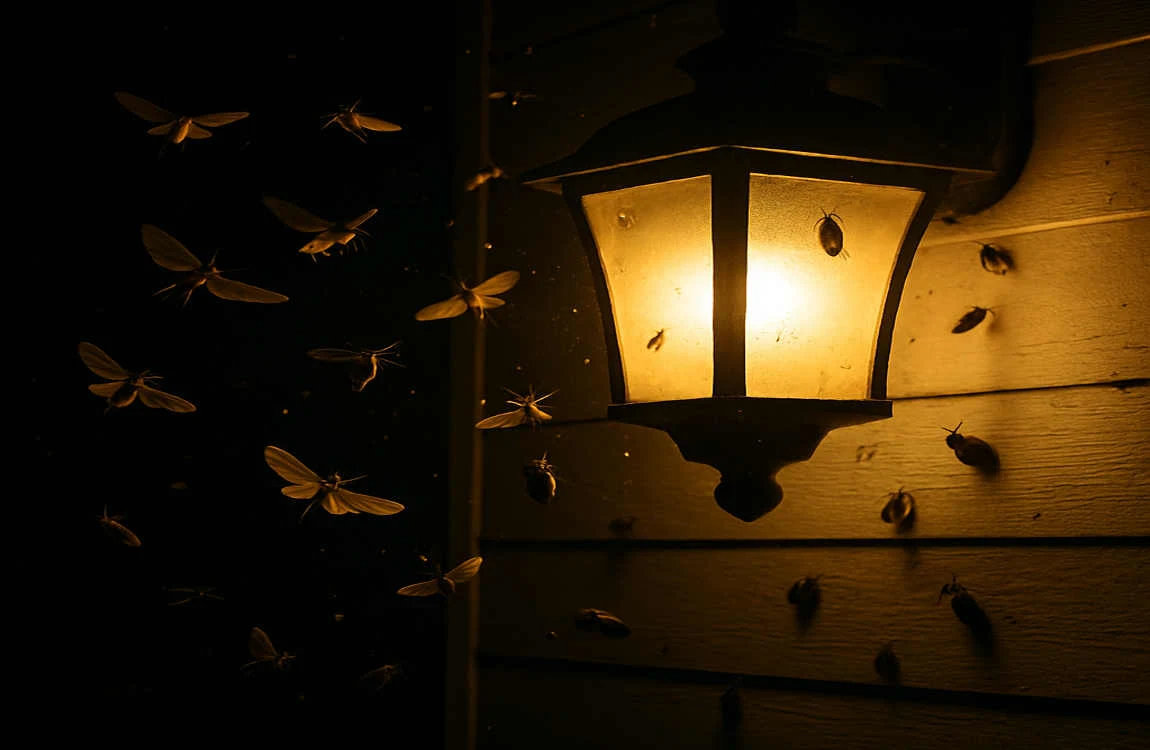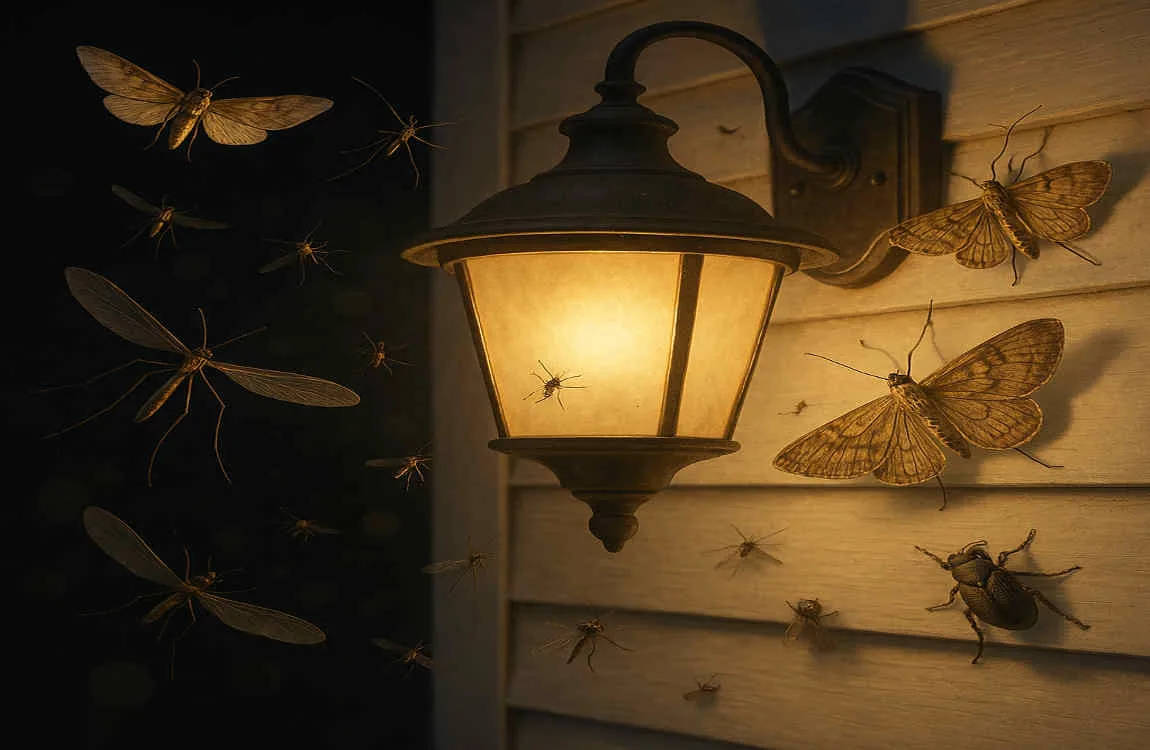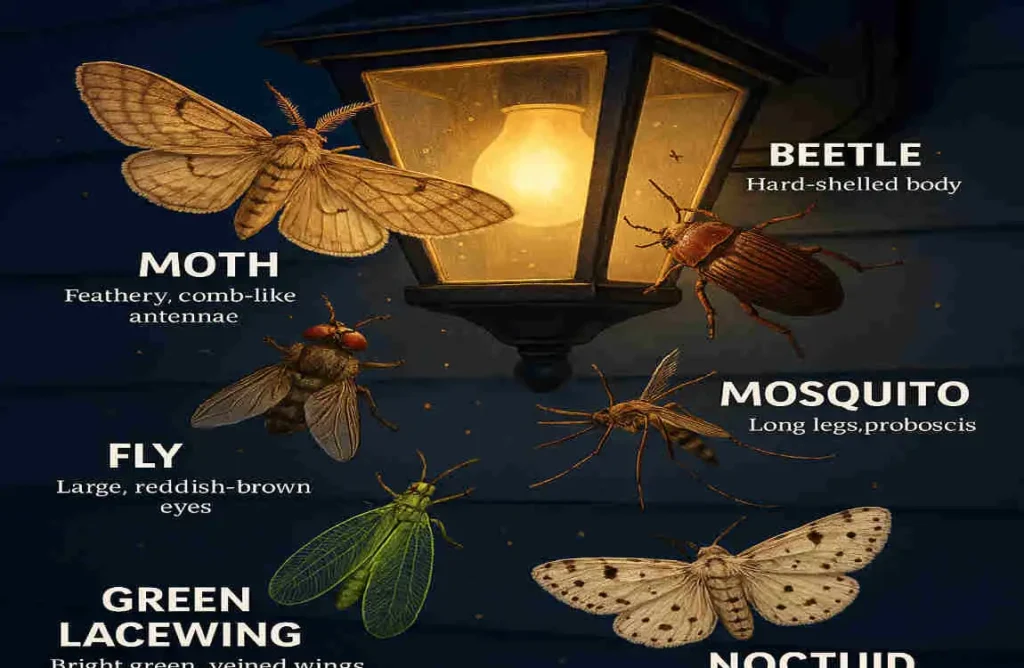Have you ever wondered why your porch light becomes a bustling hub for insects after dark? You’re not alone. Every evening, millions of homeowners witness the fascinating yet sometimes frustrating phenomenon of insects swarming around their house lights. Understanding what insects are attracted to house light can help you better manage these uninvited guests and create a more comfortable outdoor environment.
This natural occurrence affects nearly every home with outdoor lighting. From tiny gnats to large moths, various insects find artificial lights irresistible. But why does this happen? And more importantly, which specific insects are you likely to encounter?
Knowing what insects are attracted to house light isn’t just about satisfying curiosity. It’s about protecting your home from potential pest invasions, reducing annoying bug encounters during evening gatherings, and even understanding how your lighting choices impact local ecosystems. Some attracted insects are harmless pollinators, while others might be pests that could damage your property or disturb your peace.
Why Are Insects Attracted to House Lights?

The mystery of insect attraction to artificial lights has long puzzled scientists and homeowners alike. While we’ve made significant progress in understanding this behavior, the complete picture remains fascinatingly complex.
The Science Behind Light Attraction
Scientists have recently discovered that insects don’t simply fly toward lights as previously thought. Instead, they become disoriented by artificial illumination. Natural light sources, such as the moon and stars, have guided insect navigation for millions of years. When insects encounter artificial lights, their internal navigation systems go haywire.
Think of it this way: insects use celestial light to maintain their flight path, keeping the light source at a consistent angle. But unlike the distant moon, your porch light is close and stationary. This causes insects to spiral around the light in confusion, unable to maintain their intended direction.
Different Theories Explaining the Attraction
Several theories attempt to explain this behavior:
Navigation disruption remains the leading explanation. Insects evolved to use natural light for orientation during flight. Artificial lights interfere with this ancient system, causing them to become disoriented.
The escape response suggests that some insects interpret bright lights as gaps or openings. In nature, the most vibrant areas often serve as escape routes from enclosed spaces. Your house light might trigger this instinctive response.
Wavelength attraction also plays a crucial role. Different insects respond to specific wavelengths of light. UV light, for instance, proves particularly attractive to many species because flowers often reflect UV patterns invisible to human eyes.
How Light Types Affect Insect Behavior
Not all lights attract insects equally. Understanding these differences can help you make smarter lighting choices:
UV and white lights act like insect magnets. Traditional incandescent bulbs and many fluorescent lights emit high levels of UV radiation, making them incredibly attractive to bugs.
Warm LED lights attract fewer insects. These bulbs emit less UV radiation and produce light in the yellow-orange spectrum, which many insects find less appealing.
Light intensity matters significantly. Brighter lights generally attract more insects than dimmer ones. The broader the light spreads, the larger the area from which it draws insects.
Your lighting choices directly impact the number of insects that gather around your home each night. By understanding these attraction patterns, you can make informed decisions about outdoor lighting that strike a balance between visibility and insect management.
Common Insects Attracted to House Lights
Now that we understand why insects flock to lights, let’s identify the specific visitors you’re likely to encounter. Knowing what insects are attracted to house light helps you determine whether you’re dealing with harmless creatures or potential pests.
You may also read (guide to cleaning brown stains on house mattresses).
Moths
Moths rank among the most notorious light-lovers. These fuzzy-bodied insects seem almost hypnotized by artificial illumination, often spending hours circling lamps and bulbs.
Identification features make moths relatively easy to spot. Look for their distinctive, powdery wings, which leave a dusty residue when touched. Their bodies appear thick and furry, unlike their butterfly cousins. Moths typically hold their wings flat against their bodies when resting, creating a triangular silhouette.
Common moth species around house lights include:
- Clothes moths: Small, golden-brown insects about half an inch long
- Hawk moths: Large, fast-flying species with pointed wings
- Tiger moths: Colorful varieties with striking wing patterns
Moths demonstrate the strongest attraction to UV and bright white lights. You’ll often find them frantically batting against windows or clustering around porch lights. Their erratic flight patterns and persistent circling behavior make them unmistakable nighttime visitors.
Beetles
Beetles bring their hard-shelled bodies to the light party in impressive numbers. These insects create quite a racket as they bump into walls and windows near bright lights.
June bugs lead the beetle brigade around house lights. These hefty, reddish-brown insects emerge in late spring and early summer, creating a seasonal nuisance. Their loud buzzing and clumsy flight make them impossible to ignore.
Ground beetles occasionally venture toward lights despite preferring darkness. These beneficial predators help control pest populations, but sometimes become disoriented by artificial illumination.
Identification tips for beetles include:
- Hard, shell-like wing covers (elytra)
- Distinct separation between head, thorax, and abdomen
- Antennae varying from short clubs to long threads
- Sizes ranging from tiny ladybugs to thumb-sized scarabs
Beetles often crash-land near lights, temporarily stunning themselves. You’ll find them crawling on walls or lying on their backs, legs waving in the air.
Flies and Mosquitoes
These familiar pests create some of the most annoying light-attracted swarms. Understanding their behavior helps you manage their presence more effectively.
House flies gather around lights in surprising numbers. While they’re primarily day-active insects, artificial lights can extend their activity into evening hours. Look for their rapid, darting flight patterns and the metallic sheen of their bodies.
Mosquitoes present a more complex case. Despite popular belief, mosquitoes aren’t strongly attracted to lights. They use other cues, such as carbon dioxide and body heat, to locate victims. However, particular mosquito species do congregate near lights, especially during mating seasons.
Crane flies, often mistaken for giant mosquitoes, frequently appear around lights. These harmless insects have incredibly long legs and delicate bodies. They bounce clumsily off walls and ceilings, creating unnecessary panic among those who mistake them for mosquitoes.
Identification characteristics include:
- Flies: Two wings, large compound eyes, rapid movement
- Mosquitoes: Delicate bodies, long proboscis, high-pitched whine
- Crane flies: Extremely long legs, slow flight, larger than mosquitoes
Termites (Swarming Alates)
Termite swarms around lights signal a potentially serious situation. These reproductive termites, called alates, emerge from colonies to mate and establish new nests.
When to expect them: Termite swarms typically occur in spring or early summer, often after rain. If you notice winged insects resembling flying ants near your lights, take a closer look.
Key identification features:
- Straight antennae (ants have bent antennae)
- Equal-length wings that extend beyond the body
- Thick waist without the pinched appearance of ants
- Pale, soft bodies that appear almost translucent
Finding termite swarmers near your lights demands immediate attention. While the swarmers themselves don’t damage wood, their presence indicates an established colony nearby. Document their appearance and contact a pest professional promptly.
Wasps, Bees, and Other Flying Insects
While less common than moths or beetles, these insects occasionally visit house lights, creating unique identification challenges.
Wasps rarely swarm lights but might investigate bright areas while hunting other insects. Yellow jackets and paper wasps sometimes appear near lights during late evening foraging. Their smooth bodies and defined waists make them easily distinguishable from other insects, such as bees.
Bees seldom visit lights at night since they’re typically inactive after dark. However, artificial lights near hives can disrupt their behavior. If you spot bees around lights, they’re likely disoriented rather than attracted.
Other visitors include:
- Lacewings: Delicate green insects with transparent wings
- Mayflies: Short-lived insects that emerge in massive numbers
- Caddisflies: Moth-like insects that hold their wings tent-style over their bodies
Other Common Insects
Several other insects occasionally appear around house lights, each bringing unique characteristics:
Cockroaches sometimes venture near outdoor lights while foraging. These flat-bodied insects scurry quickly when disturbed. American cockroaches, the large reddish-brown variety, most commonly appear near lights.
Grasshoppers and crickets occasionally jump toward lights, especially during warm evenings. Their powerful hind legs and distinctive chirping make identification straightforward.
Stink bugs are increasingly appearing around lights as their populations expand. These shield-shaped insects release foul odors when disturbed, making them memorable visitors.
How to Identify These Insects Around Your House Lights

Successfully identifying insects around your lights requires observation skills and the right approach. Let’s explore practical methods to determine precisely which creatures are attracted to your outdoor lighting.
Visual Identification Techniques
Start with these basic observation steps:
Size assessment provides your first clue. Group insects into categories:
- Tiny (smaller than a rice grain): gnats, midges, small flies
- Small (rice to pea-sized): mosquitoes, small moths, fruit flies
- Medium (pea to nickel-sized): house flies, medium moths, most beetles
- Large (nickel-sized and bigger): large moths, June bugs, crane flies
Color and patterns offer additional identification hints. Note whether insects appear:
- Solid colored or patterned
- Metallic or dull
- Light or dark
- Fuzzy or smooth
Wing characteristics prove especially helpful. Observe:
- Number of wings (two or four)
- Wing position at rest
- Transparency or opacity
- Presence of scales or hair
Behavioral Clues for Identification
How insects move around lights reveals their identity:
Flight patterns vary significantly between species:
- Erratic spiraling: Moths and some beetles
- Hovering: Flies and some wasps
- Straight approaches: Termites and flying ants
- Clumsy bumping: June bugs and large beetles
Resting positions provide identification opportunities:
- Moths: Wings are flat or tent-like over the body
- Flies: Wings folded back along the body
- Beetles: Hard wing covers meeting in a straight line
- Dragonflies: Wings spread perpendicular to the body
Sound production helps identify certain insects:
- Loud buzzing: Large flies, bees, some beetles
- High-pitched whine: Mosquitoes
- Clicking sounds: Click beetles
- No sound: Moths, termites
You may also read (transform your home cutting rafters for lean to roofs).
Safe Identification Practices
Protect yourself while observing insects:
Maintain safe distances from potentially stinging insects. Use these guidelines:
- Stand at least 3 feet from unknown flying insects
- Never swat at wasps or bees near lights
- Avoid sudden movements that might provoke defensive behavior
Use proper tools for closer examination:
- Clear containers for temporary capture
- Magnifying glass for detailed observation
- Smartphone camera for documentation
- Thick gloves when handling containers
Best times for observation:
- Early evening: First arrivals appear
- Peak darkness: Maximum variety present
- Late night: Persistent species remain
Technology and Resources
Modern tools make insect identification easier than ever:
Smartphone apps offer instant identification:
- iNaturalist: Community-based identification
- Picture Insect: AI-powered recognition
- Seek: Real-time identification while observing
Online resources provide detailed information:
- University extension websites
- Entomology society databases
- Regional pest identification guides
Photography tips for identification:
- Use flash to capture details
- Focus on distinguishing features
- Include size reference (coin, ruler)
- Photograph from multiple angles
Creating an Identification Log
Document your observations for pattern recognition:
DateTimeWeatherInsect TypeNumberBehaviorLight Type
June 15, 9:30 PM Warm, humid Large moths 5-10 Circling LED porch light
June 16, 10:00 PM Cool, dry Small beetles 2-3 Crawling on wall Motion sensor
June 17, 9:00 PM. After rain, a swarm of 50+ termites, flying erratically. All outdoor lights
Regular logging helps you:
- Identify seasonal patterns
- Recognize problem species
- Track intervention effectiveness
- Build personal expertise
How to Minimize the Attraction of Insects to House Lights
Now that you know what insects are attracted to house light, let’s explore practical solutions to reduce their presence. Wise lighting choices and simple modifications can dramatically decrease insect gatherings.
Choosing the Right Light Types
Your bulb selection makes the most significant difference in insect attraction:
Warm LED lights offer the best solution. These bulbs emit minimal UV radiation and produce yellow-orange light that most insects find unappealing. Switch your outdoor bulbs to warm white LEDs (2700K-3000K color temperature) for immediate results.
Amber or yellow bulbs provide excellent insect deterrence. Often marketed as “bug lights,” these bulbs emit wavelengths that many insects can barely see. While not completely invisible to bugs, they attract significantly fewer insects than standard white lights.
Avoid these light types:
- Mercury vapor lamps (beautiful to insects)
- Bright white LEDs (4000K and above)
- Traditional incandescent bulbs
- Standard fluorescent tubes
Strategic Light Placement and Direction
How you position lights matters as much as bulb choice:
Downward-facing fixtures limit the spread of light and reduce the area from which insects are drawn. Shield lights with covers that direct illumination where needed while minimizing skyward glow.
Distance from entries proves crucial. Place bright lights away from doors and windows. Install them at property perimeters to draw insects away from your home’s immediate vicinity.
Height considerations:
- Lower fixtures attract insects from smaller areas
- Elevated lights draw bugs from greater distances
- Wall-mounted lights at 6-8 feet work well for most homes
Smart Lighting Solutions
Modern technology offers innovative insect management options:
Motion-activated lights remain off until needed, giving insects less time to gather. These work exceptionally well for security lighting and areas that are rarely used.
Timer systems reduce overall light exposure. Program lights to turn off during peak insect activity (typically 10 PM to 2 AM) when you’re less likely to need them.
Dimmable fixtures allow you to adjust the brightness according to your needs. Lower intensity means fewer attracted insects while still providing adequate illumination.
Physical Barriers and Modifications
Combine lighting changes with physical deterrents:
Screen installations keep insects outside even when lights attract them:
- Fine mesh screens on windows and doors
- Screened porches or patios
- Magnetic screen doors for high-traffic areas
Natural barriers using plants:
- Citronella grass near outdoor seating
- Lavender along walkways
- Marigolds in garden beds
Additional modifications:
- Install ceiling fans on covered porches (insects avoid air currents)
- Use outdoor curtains to block the spread of light
- Apply weatherstripping to seal gaps around doors
Integrated Pest Management Approach
Combine multiple strategies for the best results:
- Replace bulbs with warm LEDs or amber lights
- Adjust fixtures to minimize upward light
- Install timers or motion sensors
- Add physical barriers where needed
- Monitor and adjust based on results
Remember, complete elimination isn’t the goal. The presence of some insects indicates a healthy ecosystem. Focus on reducing nuisance levels while maintaining ecological balance.
Why This Matters: Insect Behavior and Household Impact
Understanding what insects are attracted to house light extends beyond mere curiosity. This knowledge impacts your comfort, health, property, and even the broader environment.
Home Comfort and Quality of Life
Insect swarms around lights create multiple comfort issues:
Outdoor enjoyment suffers when insects dominate evening spaces. Family dinners on the patio become battles against buzzing intruders. Children avoid playing outside after dark. Your expensive outdoor living areas sit unused during prime evening hours.
Indoor invasions occur when attracted insects find entry points. Moths slip through door gaps. Beetles crawl through window screens. Even with barriers, some insects inevitably make their way inside, disrupting your peaceful evening routines.
Sleep disturbances result from insects buzzing against bedroom windows. The constant tapping of beetles or moths against glass creates an annoying soundtrack that makes it difficult to fall asleep. Light-attracted insects can turn summer nights into restless ordeals.
Health and Safety Considerations
Some light-attracted insects pose genuine risks:
Stinging insects like wasps occasionally investigate lights while hunting. Accidental encounters near doorways can result in painful stings, especially dangerous for those with allergies.
Disease vectors sometimes appear in swarms that are attracted to light. While mosquitoes aren’t strongly drawn to lights, other biting insects might be. These pests can transmit various diseases, making their management important for family health.
Contamination concerns arise when insects enter homes. Flies attracted to outdoor lights might later land on food surfaces. Cockroaches drawn to exterior lighting can carry bacteria into living spaces.
Slip and fall hazards develop when dead insects accumulate on walkways. Large beetle die-offs create slippery surfaces after rain. Regular cleaning becomes necessary to maintain safe pathways.
Property Protection and Maintenance
Insect attraction to lights affects your property in several ways:
Termite swarms near lights signal potential structural threats. These wood-destroying insects cause billions in damage annually. Early detection through light monitoring can save thousands in repair costs.
Staining and cleaning requirements increase with heavy insect activity. Bug residue on walls, windows, and light fixtures requires frequent cleaning. Some insects leave permanent stains on light-colored surfaces.
Landscape damage occurs when certain insects congregate in large numbers. Japanese beetles attracted to lights might later attack nearby plants. Managing light attraction helps protect your garden investments.
Ecological Considerations
Your lighting choices impact the broader ecosystem:
Pollinator disruption happens when beneficial insects waste energy circling lights. Moths, important nighttime pollinators, are exhausted by artificial lights instead of visiting flowers. This disruption affects plant reproduction and food production.
Food chain interruption occurs when predators can’t find prey disoriented by lights. Bats and birds rely on the predictable behavior of insects. Light pollution interferes with these natural hunting patterns.
Population declines result from continuous exposure to artificial light. Insects die from exhaustion, predation, or collision. Scientists link light pollution to declining insect populations worldwide.
Migration interference affects insects that navigate by natural light. Artificial lights can derail migration patterns, preventing insects from reaching breeding or overwintering sites.
Making informed lighting choices helps preserve these essential ecological relationships while maintaining your comfort and safety.
You may also read (how to use bleach to eliminate ants in your home).

